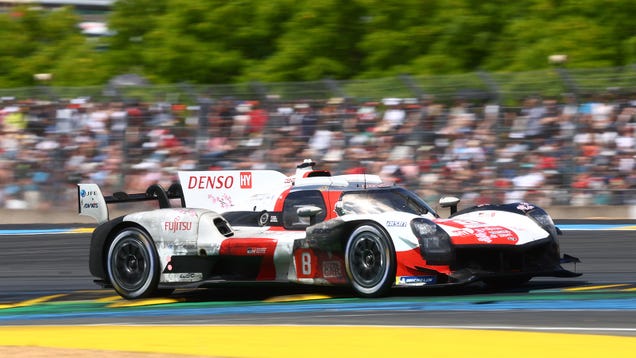Title: Toyota’s Heartbreaking Loss at the 24 Hours of Le Mans
Header 1: Introduction (100 words)
The 24 Hours of Le Mans is one of the most grueling endurance races in the world, testing the limits of both man and machine. In 2017, Toyota came agonizingly close to winning the race, only to suffer a heartbreaking loss in the final hours. This article will explore the events leading up to Toyota’s defeat and the lessons that can be learned from it.
Header 2: The Race (200 words)
The 2017 edition of the 24 Hours of Le Mans saw Toyota field two cars, the No. 7 and No. 8, with a strong driver lineup that included former Formula One driver Kamui Kobayashi and reigning World Endurance Champion Sebastien Buemi. The team had been dominant throughout the race, leading for most of the 24 hours.
However, with just two hours left in the race, Toyota found itself trailing the No. 51 Ferrari by around 15 seconds. The team decided to take a gamble and instructed 29-year-old Ryo Hirakawa to take “full risk” in order to catch up to the Ferrari. Hirakawa pushed too hard and lost control of the car, crashing into a barrier and ending Toyota’s hopes of victory.
Header 3: The Aftermath (300 words)
The loss was a devastating blow for Toyota, which had been seeking its first-ever victory at Le Mans. The team had come close in previous years, but had always fallen short. The 2017 race was supposed to be different, with Toyota leading for most of the race and looking like the clear favorite to win.
In the aftermath of the crash, there was a lot of soul-searching within the Toyota camp. The team had taken a big risk by instructing Hirakawa to push so hard, and it had backfired spectacularly. There were also questions about the car itself, which had been difficult to handle under braking throughout the race.
Despite the disappointment, Toyota vowed to come back stronger in future years. The team knew that it had the talent and the resources to win at Le Mans, and it was determined to make it happen.
Header 4: Lessons Learned (400 words)
The 2017 24 Hours of Le Mans was a painful lesson for Toyota, but it was also a valuable one. The team learned that taking unnecessary risks can have disastrous consequences, and that it’s important to stay focused and disciplined throughout the race.
Toyota also learned that it needs to continue to refine its cars in order to be competitive at Le Mans. The team had made significant improvements to its cars in previous years, but there was still work to be done. In particular, the team needed to address the handling issues that had plagued the car throughout the race.
Another lesson that Toyota learned was the importance of teamwork. Endurance racing is a team sport, and every member of the team plays a crucial role in achieving success. Toyota realized that it needed to work even harder to ensure that everyone was on the same page and working towards the same goal.
Header 5: Looking Ahead (200 words)
Despite the disappointment of 2017, Toyota remains committed to winning at Le Mans. The team has continued to refine its cars and its strategy, and it has assembled a talented driver lineup that includes former Formula One drivers Fernando Alonso and Kazuki Nakajima.
The 2018 edition of the race saw Toyota come agonizingly close once again, with both cars leading for much of the race before suffering mechanical issues in the final hours. However, the team remains undeterred and is already looking ahead to next year’s race.
Conclusion (100 words)
The 2017 24 Hours of Le Mans was a painful lesson for Toyota, but it was also a valuable one. The team learned that taking unnecessary risks can have disastrous consequences, and that it’s important to stay focused and disciplined throughout the race. Toyota remains committed to winning at Le Mans, and with its talented driver lineup and continued improvements to its cars and strategy, it’s only a matter of time before the team achieves its goal.
